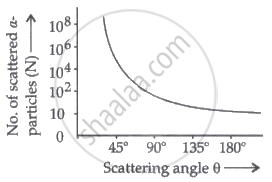Advertisements
Advertisements
प्रश्न
Draw a graph showing the variation of the number of particles scattered (N) with the scattering angle θ in the Geiger-Marsden experiment. Why only a small fraction of the particles are scattered at θ > 90°?
उत्तर
Graph showing the variation of the number of particles scattered (N) with the scattering angle (θ):

The strongly repulsive force exerted by the positively charged nucleus causes the scattering of α-particles at θ > 90°. Because the nucleus is so small, there are fewer distributed α-particles.
संबंधित प्रश्न
Answer the following question, which help you understand the difference between Thomson’s model and Rutherford’s model better.
Is the average angle of deflection of α-particles by a thin gold foil predicted by Thomson’s model much less, about the same, or much greater than that predicted by Rutherford’s model?
Answer the following question, which help you understand the difference between Thomson’s model and Rutherford’s model better.
In which model is it completely wrong to ignore multiple scattering for the calculation of average angle of scattering of α-particles by a thin foil?
An electron in an atom revolves round the nucleus in an orbit of radius r with frequency v. Write the expression for the magnetic moment of the electron.
In a Geiger-Marsden experiment, calculate the distance of closest approach to the nucleus of Z = 80, when a α-particle of 8Mev energy impinges on it before it comes momentarily to rest and reverses its direction.
How will the distance of closest approach be affected when the kinetic energy of the α-particle is doubles?
Alpha particles used in Geiger-Marsden experiment were obtained from ______.
In Geiger-Marsden experiment, actual results were ______.
The first line of Balmer series (Hα) in the spectrum of hydrogen is obtained when an electron of hydrogen atom goes from ______.
In a capillary tube, water rises by 1.2 mm. The height of water that will rise in another capillary tube having half the radius of the first is:
A radioactive nucleus (initial mass number A and atomic number Z) emits 3 α- particles and 2 positrons. The ratio of the number of neutrons to that of protons in the final nucleus will be:
Differentiate between the 'distance of the closest approach' and the 'impact parameter.'
